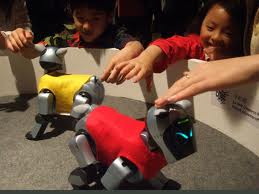
Le Petit Chaperon Rouge, by Laurent Aziosmanoff, typical of relational art.
Major Concepts of Digital/Algorithmic Art
Digital art, or digital creation, can be roughly defined as "art using the computer". But this wording is in practice too wide and too vague.
Such a definition includes nearly any activities of our days. Anybody has at least a cell phone including a computer (and a rather powerful one, when compared to the first microcomputers (1980's)), and almost any human activity today, from the morning cosmetics to the dinner cooking has some artistic quality.
We could define the digital artist as "artist who plays with code". But this time we are very
restrictive, and many "digital artists" will not accept it.
Then we must describe more precisely what is intended as "art" in diccan, what is considered as properly "digital". Then for each of these two words, we shall sweep the main concepts they put in use, and link them into the more specitic notices of this website.
Globally, the present state of digital art is the result of a long history, and we can propose some hints about its future (present version in French, dated 2011). It is present worldwide, and we have attempted to draw its geography. Without forgetting the ecological issues.
Some notes about art and science.
Art
As for art, we focus on professional artistic activities, then on people who consider themselves as artists, and are, at some degree, recognized as such by the market (private and public).
Digital creation is today present in all art forms:
- writing (generally speaking, including
poetry, storytelling, and its graphic expressions calligraphy, typography and books;
- music,
- traditional "plastic" arts : painting widely speaking, , sculpture and installations, architecture, to which we can add Infographics, design, light, LED, kinetic and robotic arts;
- on the borders of "art", but with some digital developments: cooking, perfume, hairdo, fabrics, jewelry.
- recorded images: photography, included non-photorealistic rendering, cinema and animation, video,
- live performance, theater, circus, dance, and generally live,
-
networked creation: television, transmedia, net art (including web art) and generall media,.
Other forms of art, digital or related to its digital forms:
- algorithmic art (and algorists),
- behavioral art,
- bio-art,
- conceptual art,
- copy art,
- evolutive/evolutionary art,
- fractal or fractalist art,
- games (as far as they are "art"),
- generative art,
- genetic art,
- kinetic art,
- Lego art (not digital, but for Mindstorms. (text in French).
- living art,
- locative arts,
- nano-art,
- new media, a catchll concept, we place these artists in the multimedia category (no less catchall, I confess).
- sociologic art,
(very different from social media, for which see transmedia)
- systems art,
- typewriter art (including Minitl and low-resolution art)
- viral art (a form of bio-art).
Digital art raises issues about aesthetics (and beauty even though this word is generally considered outmoded), with more or less formal criteria and choice of style, not forgetting the opposition between realism and abstraction, with new variations about virtuality, augmented reality and the many terms prefixed with "cyber".
Digital processes impact not only the contents but the whole creation process, with now forms of cooperation (and collaboration), possibly through fablabs, production (including workflow management for the large teams) and dematerialization, ending in the issues of perenniality for archives and the curating or patrimony.
And the art biotope sociology includes of course the spectator but also the curator the mediator and the critic. Art is produced in studios and "labs".
Digital
Everything, and every art, is digital... more or less.For instance, in music, a Midi file(.mdi extension) is more digital than a sampled file (.wav). In graphics, a procedural texture is more digital than a sampled one. The latter ones are more analog, they retain more of the materal structure of the coded objects, and less of their formal, deep, essential structures.
Digital is difficult to understand since
- the concept is not simple,
- three layers of digital structures are central to us humans: matter (atoms), life (DNA) and language, all three of them both hidden in the apparent continuity of matter, the cell nucleus or our education.
In few words, the core of "digital" is "code" that is assignment of a meaning to a text, with no direct correspondence (analogy) between text and meaning. See ampler developments.
Digital is the ultimate stage of fragmentation, whch may take the form of a data base.
There are different kinds and levels of digital beings. But they all
- combine form and matter,
- develop a specific behavior,
-
(many of them) perceive their environment,
- give expression of what they are and do.
Different kinds of beings
- Being, bit, agent, object, character, avatar, system.
- Life, human (general considerations), cyborg, woman, gender, spirit,
Form
- Form, symbol, model, language, grammar,
- Mathematics: formal spaces (including dimension, distance, time, topology), random, matching.- Geometry/graphic concepts: form, line, surface, volume, fractal, graph, image, pixel, color, rendering
- Filter
Matter
- Matter (and material spaces) materialization,
- Mechanics, electronics, electricity.
- Sound. Instrument.
- Time, real time.
- Body
- World
Behavior
- Automate, automatic, autonomy, liberty, behavior, complexity (general considerations)
- Algorithm, programming, recursion.
- Memory, intelligence, intention. motors, generation/generative, psychology, emotion, conscience (including transhumanism),
eroticism.
- Interaction

Net-art experience in Barcelona.
Perception
- Perception, touch. vision, keyboard, glasses.
- Measurement, meaning, semantics, recognition, emotion, pain. rank/ranking. eye, brain (direct communication from/with the brain),
Expression
Expression (including face, motion and gesture), hand, visual, haptics, speech.
- Immersion
- Print, printer, printing, cartography.
Some general references
< Les arts numériques, by Laurent Diouf, Anne Vincent and
Anne-Cécile Worms. Centre de recherche et d'information socio-politiques
2013.
< Cultures del Canvi, Atoms Socials i Vides Electoniques, Generalidad
de Catalunya, 2010. Mainly political and sociological.
< Digital and Other Virtualities. renegotiating the image. by Antony
Bryant and Griselda Pollock. J.B. Tauris 2010. Deals only marginally with art.